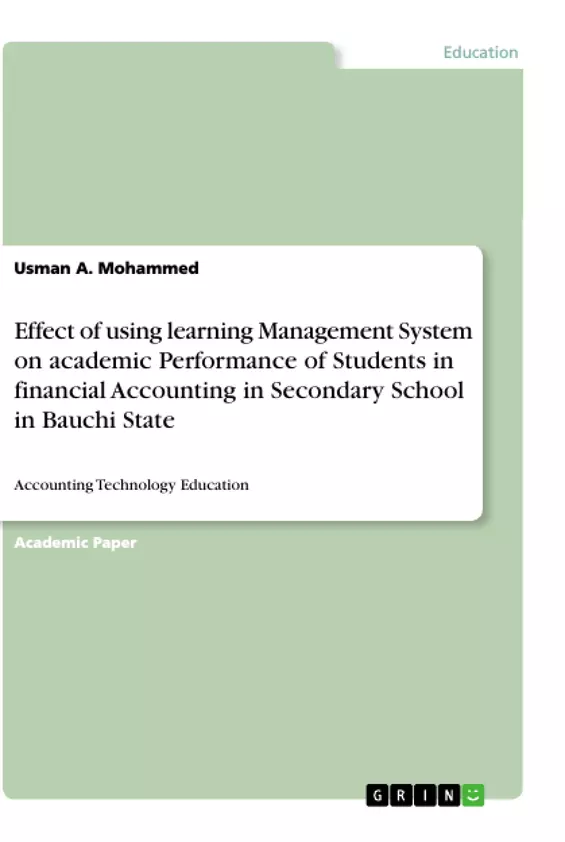This study aimed at finding out the “Effect of Using Learning Management System on Academic Performance of Students on Financial Accounting in Secondary Schools in Bauchi State”. Four specific objectives, four research questions and four related null hypotheses were formulated. The research design adopted was a quasi-experimental design. With a population of 10,790 secondary schools students II that are offering FA in Bauchi State. Purposive sampling technique was used in the selection of the students where the sample size was 240 students and also Purposive sampling technique was used in selecting the experimental and control groups. Mean and standard deviation were used to answer the four research questions. Independent sample t-test was used to test null hypothesis one and four while paired sample t-test was used in testing the null hypotheses two and three, all null hypotheses were tested at 0.05 level of significance. The findings of the study revealed among others, that there was a significant difference in the achievement of the students of SSS II taught FA using LMS tool compared to those taught using Conventional method. It was concluded that LMS is effective in teaching FA for better students’ academic performance in secondary school. Based on this finding, it was recommended among others that teachers should intensify efforts in the use of LMS tool in teaching FA in secondary schools in Bauchi State.
Inhaltsverzeichnis (Table of Contents)
- CHAPTER ONE: INTRODUCTION
- 1.1 Background of the Study
- 1.2 Statement of the Problem
- 1.3 Purpose of the Study
- 1.4 Research Questions
- 1.5 Significance of the Study
- 1.6 Scope of the Study
- 1.7 Limitation of the Study
- 1.8 Definition of Terms
- CHAPTER TWO: REVIEW OF RELATED LITERATURE
- 2.1 Concept of Learning Management System (LMS)
- 2.2 Benefits of Using LMS in Education
- 2.3 Challenges of Using LMS in Education
- 2.4 The Use of LMS in Teaching Financial Accounting
- 2.5 Theoretical Framework
- 2.6 Conceptual Framework
- CHAPTER THREE: RESEARCH METHODOLOGY
- 3.1 Research Design
- 3.2 Population of the Study
- 3.3 Sample and Sampling Technique
- 3.4 Instruments for Data Collection
- 3.5 Validation of the Instrument
- 3.6 Reliability of the Instrument
- 3.7 Method of Data Collection
- 3.8 Method of Data Analysis
- CHAPTER FOUR: PRESENTATION, ANALYSIS AND INTERPRETATION OF DATA
- 4.1 Data Presentation
- 4.2 Data Analysis
- 4.3 Interpretation of Data
- CHAPTER FIVE: SUMMARY, CONCLUSION AND RECOMMENDATIONS
- 5.1 Summary of Findings
- 5.2 Conclusion
- 5.3 Recommendations
- 5.4 Implications of the Study
- 5.5 Suggestions for Further Research
Zielsetzung und Themenschwerpunkte (Objectives and Key Themes)
This research aims to investigate the impact of using a Learning Management System (LMS) on students' academic performance in Financial Accounting (FA) in secondary schools in Bauchi State. The study examines whether integrating LMS tools into the teaching process significantly improves student achievement compared to conventional teaching methods.
- The effectiveness of LMS tools in teaching FA in secondary schools
- The impact of LMS implementation on students' academic performance
- The challenges and benefits of integrating LMS into educational practices
- The significance of LMS in improving the quality of FA education
- The potential for future research on the role of LMS in educational settings
Zusammenfassung der Kapitel (Chapter Summaries)
Chapter One: Introduction outlines the background, statement of the problem, purpose, research questions, significance, scope, limitations, and definition of terms related to the study. It sets the context for the research by discussing the importance of LMS in education and its potential for enhancing student learning in FA.
Chapter Two: Review of Related Literature provides a comprehensive overview of the existing literature on LMS, its benefits and challenges, and its application in teaching FA. This chapter explores the theoretical framework and conceptual framework underpinning the research.
Chapter Three: Research Methodology details the research design, population, sample, sampling techniques, data collection instruments, validation and reliability of the instruments, data collection methods, and data analysis methods employed in the study.
Chapter Four: Presentation, Analysis, and Interpretation of Data presents, analyzes, and interprets the data collected through the study. This chapter focuses on examining the relationship between the use of LMS and student achievement in FA.
Schlüsselwörter (Keywords)
This research focuses on the use of Learning Management Systems (LMS) and their impact on the academic performance of students in Financial Accounting (FA). Key themes include educational technology, teaching methodologies, student achievement, and the use of digital learning platforms. The study investigates the potential of LMS to enhance the effectiveness of FA instruction in secondary schools in Bauchi State.
- Citar trabajo
- Usman A. Mohammed (Autor), 2021, Effect of using learning Management System on academic Performance of Students in financial Accounting in Secondary School in Bauchi State, Múnich, GRIN Verlag, https://www.grin.com/document/983916



